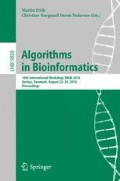Abstract
Genomic repeats are the most important challenge in genomic assembly. While for single genomes the effect of repeats is largely addressed by modern long-read sequencing technologies, in metagenomic data intra-genome and, more importantly, inter-genome repeats continue to be a significant impediment to effective genome reconstruction. Detecting repeats in metagenomic samples is complicated by characteristic features of these data, primarily uneven depths of coverage and the presence of genomic polymorphisms. The scaffolder Bambus 2 introduced a new strategy for repeat detection based on the betweenness centrality measure – a concept originally used in social network analysis. The exact computation of the betweenness centrality measure is, however, computationally intensive and impractical in large metagenomic datasets. Here we explore the effectiveness of approximate algorithms for network centrality to accurately detect genomic repeats within metagenomic samples. We show that an approximate measure of centrality achieves much higher computational efficiencies with a minimal loss in the accuracy of detecting repeats in metagenomic data. We also show that the combination of multiple features of the scaffold graph provides a more effective strategy for identifying metagenomic repeats, significantly outperforming all other commonly used approaches.
Access this chapter
Tax calculation will be finalised at checkout
Purchases are for personal use only
References
Brandes, U.: A faster algorithm for betweenness centrality*. J. Math. Sociol. 25(2), 163–177 (2001)
Dayarian, A., Michael, T.P., Sengupta, A.M.: SOPRA: scaffolding algorithm for paired reads via statistical optimization. BMC Bioinform. 11(1), 1 (2010)
Delcher, A.L., Salzberg, S.L., Phillippy, A.M.: Using MUMmer to identify similar regions in large sequence sets. Curr. Protocols Bioinform. 10.3.1–10.3.18 (2003). Chapter 10:Unit 10.3
Gao, S., Sung, W.-K., Nagarajan, N.: Opera: reconstructing optimal genomic scaffolds with high-throughput paired-end sequences. J. Comput. Biol. 18(11), 1681–1691 (2011)
Garey, M., Johnson, D.: Computers and Intractability - A Guide to NP-Completeness. W.H. Freeman & Co., New York (1979)
Geisberger, R., Sanders, P., Schultes, D.: Better approximation of betweenness centrality. In: ALENEX, pp. 90–100. SIAM (2008)
Huson, D.H., Reinert, K., Myers, E.W.: The greedy path-merging algorithm for contig scaffolding. J. ACM (JACM) 49(5), 603–615 (2002)
Fass, J.N., Joshi, N.A.: Sickle: a sliding-window, adaptive, quality-based trimming tool for FastQ files (version 1.33)
Kececioglu, J.D., Myers, E.W.: Combinatorial algorithms for DNA sequence assembly. Algorithmica 13(1–2), 7–51 (1995)
Kingsford, C., Schatz, M.C., Pop, M.: Assembly complexity of prokaryotic genomes using short reads. BMC Bioinform. 11(1), 21 (2010)
Koren, S., Phillippy, A.M.: One chromosome, one contig: complete microbial genomes from long-read sequencing and assembly. Curr. Opin. Microbiol. 23, 110–120 (2015)
Koren, S., Treangen, T.J., Pop, M.: Bambus 2: scaffolding metagenomes. Bioinformatics 27(21), 2964–2971 (2011)
Langmead, B., Salzberg, S.L.: Fast gapped-read alignment with Bowtie 2. Nat. Methods 9(4), 357–359 (2012)
Liaw, A., Wiener, M.: Classification and regression by randomforest. R News 2(3), 18–22 (2002)
Lilliefors, H.W.: On the Kolmogorov-Smirnov test for normality with mean and variance unknown. J. Am. Stat. Assoc. 62(318), 399–402 (1967)
Madduri, K., Ediger, D., Jiang, K., Bader, D.A., Chavarria-Miranda, D.: A faster parallel algorithm and efficient multithreaded implementations for evaluating betweenness centrality on massive datasets. In: 2009 IEEE International Symposium on Parallel and Distributed Processing, IPDPS 2009, pp. 1–8. IEEE (2009)
Medvedev, P., Georgiou, K., Myers, G., Brudno, M.: Computability of models for sequence assembly. In: Giancarlo, R., Hannenhalli, S. (eds.) WABI 2007. LNCS (LNBI), vol. 4645, pp. 289–301. Springer, Heidelberg (2007)
Mitchell, L., Sloan, T.M., Mewissen, M., Ghazal, P., Forster, T., Piotrowski, M., Trew, A.S.: A parallel random forest classifier for R. In: Proceedings of the Second International Workshop on Emerging Computational Methods for the Life Sciences, pp. 1–6. ACM (2011)
Peng, Y., Leung, H.C., Yiu, S.-M., Chin, F.Y.: Meta-IDBA: a de novo assembler for metagenomic data. Bioinformatics 27(13), i94–i101 (2011)
Pop, M., Kosack, D.S., Salzberg, S.L.: Hierarchical scaffolding with bambus. Genome Res. 14(1), 149–159 (2004)
Riondato, M., Kornaropoulos, E.M.: Fast approximation of betweenness centrality through sampling. In: Proceedings of the 7th ACM International Conference on Web Search and Data Mining, pp. 413–422. ACM (2014)
Salmela, L., Mäkinen, V., Välimäki, N., Ylinen, J., Ukkonen, E.: Fast scaffolding with small independent mixed integer programs. Bioinformatics 27(23), 3259–3265 (2011)
Shakya, M., Quince, C., Campbell, J.H., Yang, Z.K., Schadt, C.W., Podar, M.: Comparative metagenomic and RRNA microbial diversity characterization using archaeal and bacterial synthetic communities. Environ. Microbiol. 15(6), 1882–1899 (2013)
Treangen, T.J., Koren, S., Sommer, D.D., Liu, B., Astrovskaya, I., Ondov, B., Darling, A.E., Phillippy, A.M., Pop, M.: MetAMOS: a modular and open source metagenomic assembly and analysis pipeline. Genome Biol. 14(1), R2 (2013)
Acknowledgements
We thank Chris Hill for helping us with generating Fig. 1 and experiments. We also thank Todd Treangen for helping us to improve the manuscript and design experiments.
Author information
Authors and Affiliations
Corresponding author
Editor information
Editors and Affiliations
Rights and permissions
Copyright information
© 2016 Springer International Publishing Switzerland
About this paper
Cite this paper
Ghurye, J., Pop, M. (2016). Better Identification of Repeats in Metagenomic Scaffolding. In: Frith, M., Storm Pedersen, C. (eds) Algorithms in Bioinformatics. WABI 2016. Lecture Notes in Computer Science(), vol 9838. Springer, Cham. https://doi.org/10.1007/978-3-319-43681-4_14
Download citation
DOI: https://doi.org/10.1007/978-3-319-43681-4_14
Published:
Publisher Name: Springer, Cham
Print ISBN: 978-3-319-43680-7
Online ISBN: 978-3-319-43681-4
eBook Packages: Computer ScienceComputer Science (R0)

